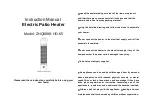
ON
OFF
ATTENTION
■
The following explains a typical procedure to be followed
in checking gas pressures.
■
The gas pressures will vary depending upon fuel type.
■
Consult the dataplate on the heater or page 4 in this
manual for specific pressures to be used in conjunction
with this procedure.
■
Gas pressure measured at the inlet to the gas valve is
Inlet Pressure and gas pressure measured at the outlet
of the gas valve is Burner Manifold Pressure.
A. Preparation
1. Obtain two pressure gauges capable of reading up to
35 In.W.C./8.7 kPa.
2. Disconnect the heater from the electrical supply and
close the fuel supply valve to the heater inlet.
3. Open the burner access panel.
4. Brush or blow off any dust and dirt on or in the vicinity
of the gas control valve.
B. Gauge Installation
1. Locate the inlet and outlet pressure taps. See Fig.
26. Remove the pressure tap plug using a 3/16 in.
allen key.
FIG. 26
2. Securely connect a pressure gauge to each pressure
tap.
3. Open the fuel supply valves to the heater and
reconnect the heater electrical supply.
4. Start the heater
C. Reading Pressures
1. With the heater operating, the pressure gauges
should read the pressures specified on the dataplate.
2. Do the readings at the inlet and outlet pressure
gauges agree with that specified on the dataplate?
If so, then no further checking or adjustment is
required. Proceed to section D.
3. If the inlet pressures do not agree with that specified
on the dataplate, then the regulator controlling gas
pressure to the heater requires adjustment.
4. If the inlet pressures are correct and the burner
manifold pressure does not agree with that specifed
on the dataplate, then the gas control valve’s internal
pressure regulator requires adjustment. See Fig. 27
for regulator location.
FIG. 27
D. Completion
1. Once the proper inlet and burner manifold pressures
have been confirmed and/or properly set, close the
fuel supply valve to the heater and allow the heater to
burn off any gas remaining in the gas supply line.
2. Disconnect the heater from its electrical supply.
3. Remove the gauges and connecting hoses.
4. Install pressure tap plugs and tighten securely.
Check for gas leaks.
WARNING
■
Do not disassemble the gas control valve.
■
Do not attempt to replace any components of the gas
control valve.
■
The gas control valve must be replaced if any physical
damage occurs to the control valve assembly.
■
Failure to follow this warning will result in fire or
explosions, leading to injury or death to humans, and
property damage.
20
EXAMPLE SHOWS PRESSURE FOR PROPANE GAS
ALWAYS REFER TO PRESSURE ON DATAPLATE
OUTLET PRESSURE TAP
INLET PRESSURE TAP
GAS PRESSURE CHECKS
Summary of Contents for Premier TS080
Page 2: ......














































